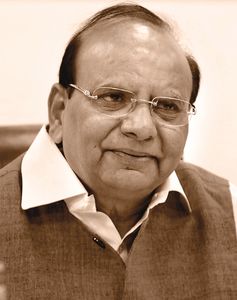Khadi saves water, has zero carbon footprint, creates expansive employment at the village level and is swadeshi—a perfect Gandhian product. V.K. Saxena, chairman of Khadi and Village Industries Commission (KVIC), talks about how his organisation is giving a different dimension to Gandhi’s vision. Edited excerpts:
What is the share of khadi today in textile industry in India?
In 2014-2015, khadi’s share was only 4.23 per cent of the overall textile production. However, in 2018-2019, it was 8.49 per cent.
This steep rise is due to the repeated appeals of Prime Minister Narendra Modi to adopt khadi. We started registration of new khadi institutions as well as revival of defunct khadi institutions, for widening the scope for employment. Consequently, the number of artisans rose to 4,94,684.
How many jobs did KVIC create in the last five years?
Amid much debate about job crisis in the nation, KVIC has created 21,70,702 new jobs through its various schemes. This includes 20,63,304 under Prime Minister Employment Generation Programme (PMEGP), 62,737 in khadi sector, 34,310 under Kumhar Sashaktikaran Yojana (KSY) and 10,315 under Honey Mission.
KVIC as the nodal agency of PMEGP had taken various steps of digitisation. On July 1, 2016, KVIC launched its own online portal which has brought transparency and expedited disbursement of margin money subsidy under PMEGP.
There is an increased interest in khadi today.
To make khadi a fashionable fabric, KVIC has taken initiatives involving corporate brands and PSUs. KVIC has also signed an MoU with the National Institute of Fashion Technology (NIFT) for better design development and training at different khadi institutions. KVIC has initiatives to ensure retail presence to khadi in major malls and retail stores. Designer intervention, which involves reputable designers like Ritu Beri, is also planned to introduce trendy designs in khadi.
Also read
- PM Modi pays homage to Mahatma Gandhi at Rajghat
- Rediscovering peace at Gandhi's Sevagram Ashram
- 'Tatva' of Gandhi's philosophy remains same, 'tantra' will differ
- Mahatma Gandhi's ideas for the world
- Many faces of Gandhi
- The unknown Gandhi: The extraordinary journey from Mohandas to Mahatma
- Canonising Gandhi made him a myth more than a man: Mark Tully
- What Gandhi wanted for India
- Gandhi was not a caste abolitionist: Kancha Ilaiah Shepherd
- Gandhian philosophy needs to be practised: Tushar Gandhi
KVIC has initiatives for remote areas in the country.
Following the clarion call of “sweet revolution” given by prime minister, KVIC launched the Honey Mission in August 2017. It identified the farmers and unemployed youth, and distributed beeboxes with live beecolonies. During this process, it broke the world record in distributing maximum number of beeboxes in a single day.
Under KSY, we have distributed 9,198 electric potter wheels to the marginalised potters. We even reached the remotest areas of Leh-Ladakh to create employment opportunities. We held training programmes and distributed 100 modern charkhas, 20 modern looms and 100 electric potter wheels, besides blungers and pug-mills in three villages of Leh.
We also distributed new model charkhas and looms in the remotest areas of Himachal Pradesh, Gujarat, West Bengal, Assam, Jammu and Kashmir and other states. KVIC distributed charkhas and launched spinning and bee-keeping programmes for tiger-attack survivors of Bali island in Sunderbans, West Bengal.
What would you consider the golden years of KVIC since its inception in 1956?
Undoubtedly, it is the ongoing period after 2015, when khadi was promoted by none other than its biggest brand ambassador, Prime Minister Narendra Modi.



